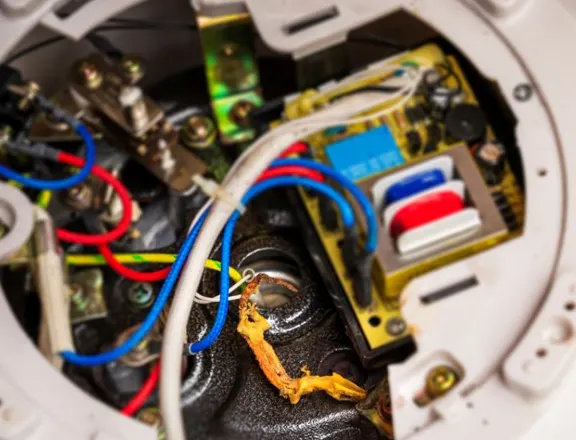An overheating rice cooker will not only mess up your meal plan but can also lead to other dangerous side effects. An overheating rice cooker can melt the outer case of the rice cooker. Additionally, it can explode and start a fire if it gets too hot. It can also cause electric circuit damage when it blows up fuses and trips your breaker. All of these issues are expensive to fix and are better off being avoided.
Common Reasons Why Your Rice Cooker is Overheating
Before you start troubleshooting your rice cooker, check if your rice cooker has enough water. As simple as it sounds, it is possible that your rice cooker is overheating because it does not have enough water.
Once you have established that this is not the issue, then you can move on to actual troubleshooting. The main reason why a rice cooker overheats is because it has a faulty thermostat. It can also overheat due to a faulty heating element, a damaged thermal fuse, or a damaged circuit board.
Faulty Thermostat
This thermostat is responsible for measuring the temperature inside your rice cooker. It is connected to the rice cooker’s heating element and sends signals to your heating element to reduce or increase temperature, depending on the situation.
If the thermostat cannot detect excess temperature, it will be unable to regulate the temperature to reduce it to match your selected cooking setting. When this happens, your rice cooker can overheat.

Solution:
Test the thermostat and replace it if necessary.
How to test your rice cooker’s thermostat
- Unplug your rice cooker and let it cool down.
- Unscrew the screws holding the outer case in place and remove them.
- Open up your rice cooker and locate the thermostat.
- Then, test the thermostat for conductivity using a multimeter.
- Replace the thermostat if there is no conductivity.
- However, it is best to hire a trained professional to do it.
Note: Electrocution may occur if you do not follow the right procedure. Do not attempt to replace the thermostat if you do not have any electrical knowledge. Additionally, you may void your warranty or damage the rice cooker.
Faulty Heating Element
Your heating element uses electricity from your rice cooker’s power cord and transforms it into heat. It depends on the thermostat temperature regulation to increase or decrease heat production.
If the heating element cannot detect the thermostat’s temperature regulation signals, it will overheat and burn your rice.
Solution:
- Take a screwdriver and remove the screws from the bottom of your rice cooker.
- Then, pull off the bottom part, detach the heating element from the rice cooker, and test it using a multimeter.
- Place one probe of the multimeter on the loosened screw and the other probe on the remaining screw attached to the face of the heating element.
- The multimeter should read between 10 and 30 ohms if the heating element works correctly.
- If you get a very low or zero reading, it indicates a faulty heating element that needs replacement.
How to replace a faulty heating element:
- Ensure the rice cooker is turned off and unplugged before you start this process.
- Locate the wire connected to the heating element. You can refer to your user manual for more guidance.
- Disconnect the wire that’s connected to the heating element and detach the heating element from the rice cooker.
- Turn your rice cooker back up, open the lid, and remove the pot.
- Then, remove the heating element from the rice cooker.
- Replace with the new coil and reassemble the rice cooker.
Notes:
- If your rice cooker’s layout differs, follow your rice cooker’s user manual’s step-by-step guide when replacing your rice cooker’s heating element.
- If unsure you can handle the task, take your rice cooker to a professional for assistance.
Damaged Thermal Fuse
A thermal fuse protects your rice cooker from a thermal spike. If the thermal fuse is damaged, it will not be able to prevent excessive power from reaching your rice cooker’s heating element, leading to overheating.

Solution:
- Ensure the rice cooker is turned off and unplugged.
- Use a screwdriver to remove the bottom of the rice cooker.
- Inspect the thermal fuse and if you see any signs of burnout it is damaged and should be replaced. If there are no signs of damaged use a multimeter to test conductivity.
- If it is not conducting electricity, replace it.
How to replace the thermal fuse
- Pry the wires connecting the thermal fuse gently.
- Unscrew the screw and sheath attached to the Thermal Fuse and remove the Thermal Cutout.
- Then insert a new thermal fuse and reconnect the Thermal Fuse.
- Replace the attach the rubber sheath, and screw the bolts back.
- Lastly, assemble the bottom compartment of the rice cooker.
Notes:
- Get a new Thermal Fuse with the same parameters and replace the old one with it.
- Continual thermal fuse burnout indicates that your rice cooker is done for and should be replaced.
Damaged Circuit Board

The control board controls all the settings responsible for cooking food in your rice cooker. In advanced rice cookers, the control board is much more advanced and sends off different commands. A faulty control board will not be able to send a signal telling the rice cooker to cook food at a lower temperature, thus leading to overheating.
Solution:
- Take your rice cooker to a certified electrician to replace the control board.
Loose Wiring
Loose wires can cause internal circuitry issues or prevent the power from reaching the appropriate place to properly run the rice cooker.
Solution:
- Open the rice cooker and inspect the wiring to see if there are any loose connections.
- Then tighten up the loose connections.
- If this does not work take your rice cooker to a professional for assistance.
